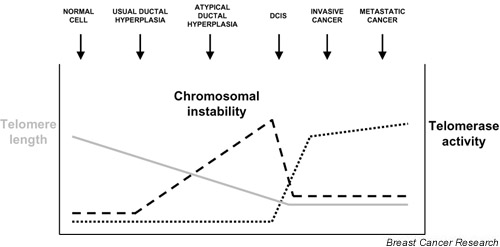Figure 1.

Telomere dynamics and chromosomal instability during human breast cancer development. Telomeres shorten during human tumorigenesis (gray line) and then become stabilized at the ductal carcinoma in situ (DCIS) or invasive stage. Telomerase is expressed at low or undetectable levels in normal cells, but becomes activated in 80–90% of DCIS lesions and remains highly active in invasive and metastatic breast cancers (dotted black line). Comparative genome hybridization analyses have shown that chromosomal imbalances or gene copy number changes begin early in breast cancer, in usual ductal hyperplasia and atypical ductal hyperplasia. Copy number aberrations increase in DCIS and remain similar in number in invasive cancer and metastatic cancer. Chromosomal instability (dashed black line) therefore begins in usual ductal hyperplasia and increases through DCIS development. The rate of accumulation of chromosomal aberrations slows significantly at the DCIS stage and this stabilization of the breast cancer genome coincides temporally with reactivation of telomerase.
